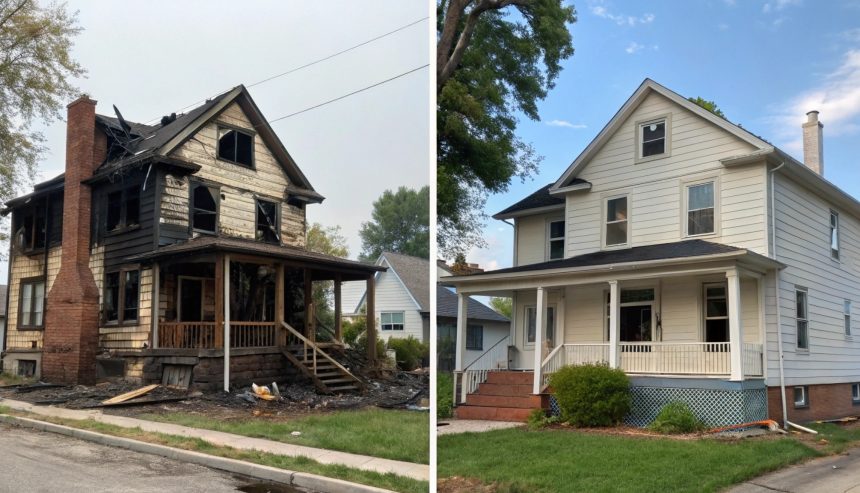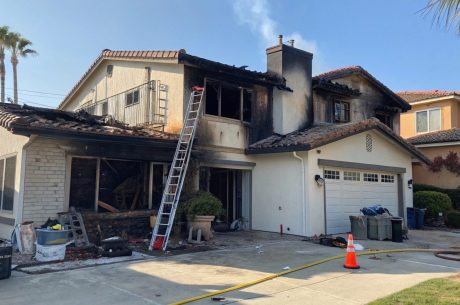Experiencing a fire in your home can be heartbreaking. The aftermath is messy, stressful, and often confusing. But repairing fire damage isn’t as straightforward as a regular home renovation, it’s a specialized process with unique challenges. From hidden dangers to emotional struggles, knowing these differences early can help you manage stress, save money, and recover faster.
In this blog, we’ll explore exactly why the fire damage restoration process demands a different approach than typical renovations.
Defining the Basics: Renovation vs. Restoration
Before diving into the differences, it’s important to understand what each process entails.
Renovation: Home renovation is a planned effort to improve, update, or modernize a living space, often driven by personal preferences or lifestyle upgrades. It’s typically an elective, focusing on aesthetics, layout, and functionality.
Restoration: Fire damage restoration is a necessary and urgent response to a disaster. It involves repairing structural damage, eliminating hazardous substances like soot and smoke, and ensuring the home is safe and habitable again. While renovation is about enhancement, restoration is about recovery and returning the home to its original condition after a crisis.
A Different Starting Point: Urgency vs. Planning
Unlike a renovation that starts with vision boards and contractor quotes, fire restoration begins under pressure and on a strict timeline.
Emergency Response Is Immediate, Not Optional
In a renovation, you might wait weeks for contractors to start. In contrast, fire restoration crews arrive within 24 hours to prevent secondary damage. Their work includes emergency board-ups, roof tarping, and water removal, none of which apply to a regular home improvement.
This sense of urgency is the first major difference between the fire damage restoration process and a standard remodeling job.
Structural Evaluations Are Safety-Driven, Not Cosmetic
Renovations inspect structures for layout or efficiency. Fire restoration inspections for life-threatening instability. Burned beams, weakened foundations, and saturated drywall must be assessed immediately. In remodeling, there’s flexibility. In restoration, delay could mean collapse.
Contaminants Take Center Stage
Restoration and renovation differ significantly in the type of materials they handle. In restoration, the focus is on hazardous residue, not just outdated design.
Cleaning Means Decontamination, Not Dusting
Unlike renovations that clean up sawdust, fire damage restoration requires specialized equipment to remove carcinogens, soot, and toxins. Air scrubbers, HEPA filters, and ozone machines are used to neutralize harmful particles—a task not needed in cosmetic remodeling.
This deeper level of environmental remediation marks a sharp contrast from the basic cleanup done in traditional renovations.
Odor Elimination vs. Surface Refreshing
Odor in remodeling comes from paint or adhesives. In the fire damage restoration process, odor comes from deeply embedded smoke. Where air fresheners suffice in renovations, restoration uses fogging machines and molecular odor neutralizers to purify the space.
Restoration Saves Materials, Remodeling Replaces Them
Another core difference lies in how both processes treat existing home elements.
Preservation Replaces Demolition
In renovation, older features are often removed and replaced to achieve a new look. In restoration, the goal is to save whatever can be safely salvaged. Structural elements like framing and subfloors are treated with antimicrobial and odor-sealing agents rather than demolished.
This careful decision-making reduces waste and speeds up recovery, something rarely prioritized in a typical home upgrade.
Removal Is Based on Health Risk, Not Age
In a remodel, materials are replaced because they’re dated. In fire restoration, they’re removed only if they pose a contamination risk, such as moisture that leads to mold or insulation soaked with smoke. The motivation behind what stays and what goes is completely different.
Insurance Dictates the Process, Not the Homeowner
One of the most misunderstood differences between these two processes is who controls the budget and timeline.
Claims Drive Every Phase
Renovation budgets are usually set by the homeowner. But in a home renovation after a fire, insurance adjusters approve every repair. Restoration companies must submit documentation, cost breakdowns, and photos to receive the go-ahead on every stage.
This insurance oversight shifts control away from the homeowner and significantly shapes the pace of the fire damage restoration process.
Progress Stops Without Paperwork
In a typical remodel, if drywall arrives late, contractors move to another room. In restoration, delays in claim approvals can stall the entire project. The legal and financial entanglements with insurance are unique to restoration.
Human Sensitivity Matters More in Restoration
Renovations are exciting projects. Restoration involves memories. The emotional stakes are vastly different.
Emotional Intelligence Over Aesthetic Taste
In remodeling, contractors focus on style, color palettes, and layout. In fire restoration, professionals also need empathy, patience, and emotional awareness. Homeowners are grieving and overwhelmed, and restoration crews are trained to communicate with care.
This emotional dimension is a defining characteristic of fire recovery work.
Memories Over Makeovers
Items like family heirlooms, children’s drawings, and wedding photos don’t factor into a renovation, but they’re central in restoration. Contents specialists use ultrasonic cleaning or cryogenic preservation to restore personal belongings, something completely absent in renovation scenarios.
Certification Sets Restoration Apart
While both types of work require skill, the certifications involved in restoration are far more specialized.
Restoration Follows Industry Protocols
The fire damage restoration process must follow IICRC guidelines for cleaning, sanitization, moisture removal, and fire residue handling. Renovation has no such standardized playbook. This means the margin for error in restoration is much smaller, and the liability is much higher.
Training Is Crisis-Oriented
Renovation teams train for precision and efficiency. Restoration teams train for chaos, urgency, and contamination. Their work often includes biohazard handling, mold remediation, and emergency logistics, far beyond what’s needed in design-driven projects.
Rebuilding Restores the Past, Not Just the Property
Renovations often aim to transform. Restoration strives to preserve and recover.
The Goal Is Normalcy, Not Novelty
Where remodels focus on change, the objective of the fire damage restoration process is to return the home to its previous condition. Families want to feel “at home” again, not necessarily upgrade their space, but restore its familiarity.
Legacy Preservation Is Built into the Process
Restoration specialists work to replicate design features, match wood stains, and recover historical trims to maintain the home’s identity. This attention to memory and meaning doesn’t factor into most renovations, where new is the default goal.

Conclusion
At first glance, both fire restoration and home renovation involve fixing and improving a home. But the fire damage restoration process is fundamentally different in place, purpose, method, and mindset.
It’s shaped by emergency needs, health risks, emotional trauma, and insurance frameworks, none of which exist in a standard remodel. A home renovation after a fire demands not just skilled construction but certified restoration, regulated safety, and heartfelt care. Knowing these differences allows homeowners to choose the right professionals, set realistic expectations, and rebuild their lives with confidence and clarity.
FAQs
Q1. How soon should fire restoration begin after the incident
A: Restoration should begin within 24 to 48 hours to prevent secondary damage like mold or structural rot.
Q2. How do I know if my house is safe to enter after a fire
A: Only enter once the fire department and a structural engineer confirm it’s safe. Always wear PPE to avoid toxic exposure.
Q3. How much of my personal property can typically be restored
A: Depending on the fire’s severity, many soft goods and electronics can be restored using specialty cleaning methods.
Q4. How long does it take to fully restore a fire-damaged home
A: Timelines vary based on damage extent, insurance processing, and permit delays, but expect anywhere from one to six months.
Q5. How do I choose between rebuilding and buying a new home
A: Evaluate cost, insurance coverage, sentimental value, and structural integrity with input from a certified restoration consultant.



